Texas is home to many different types of birds, including the beautiful blue bird. These stunning birds are a symbol of hope and happiness and can be found throughout the state. Bluebirds are found in a variety of habitats including woodlands, grasslands, and urban areas.
They are also known to feed on a variety of foods including insects, berries, and seeds. The bluebird is an important part of the Texas ecosystem as it helps to control the insect population and disperse seeds.
These cheerful birds are a delight to watch and their presence is an indication of a healthy environment.
1. Bluebirds
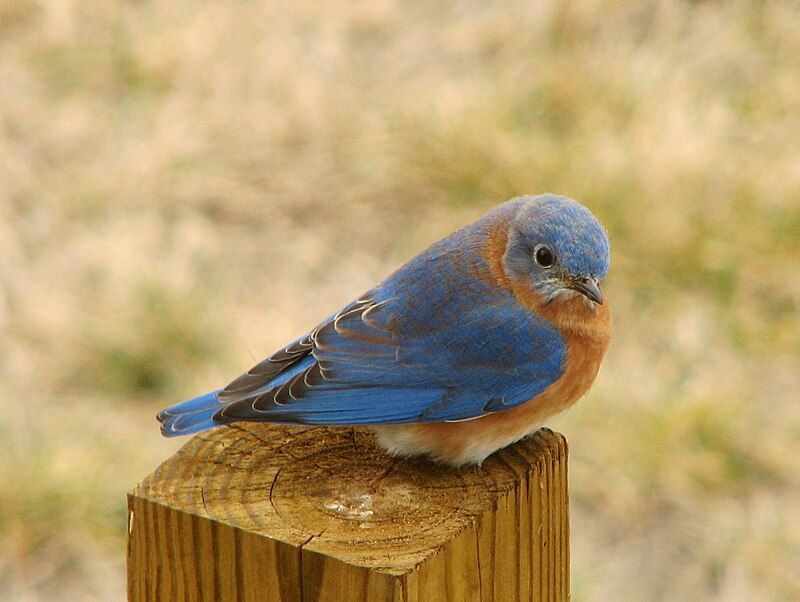
Bluebirds are a species of birds that can be found in North America. They are medium-sized birds, ranging from 5.5 to 8.3 inches long, and they are either insectivorous or omnivorous, which means they eat both insects and other types of food.
They belong to the order Passerines, which includes songbirds and perching birds, and the genus Sialia, which is a type of thrush. Bluebirds are one of the few thrush genera that can be found in the Americas. Female bluebirds lay an average of 4 to 6 eggs at a time.
The eggs are typically white with brown spots and are laid in a nest made of grass and lined with feathers. The female bluebird will then incubate the eggs for approximately two weeks, while the male provides food for her and the nestlings.
Once the eggs hatch, the chicks will be fed a diet of insects and berries until they are ready to fledge, at which point they will be able to fly on their own.
| Kingdom | Animalia |
| Phylum | Chordata |
| Class | Aves |
| Order | Passeriformes |
| Family | Turdidae |
| Genus | Sialia |
2. Eastern Bluebird
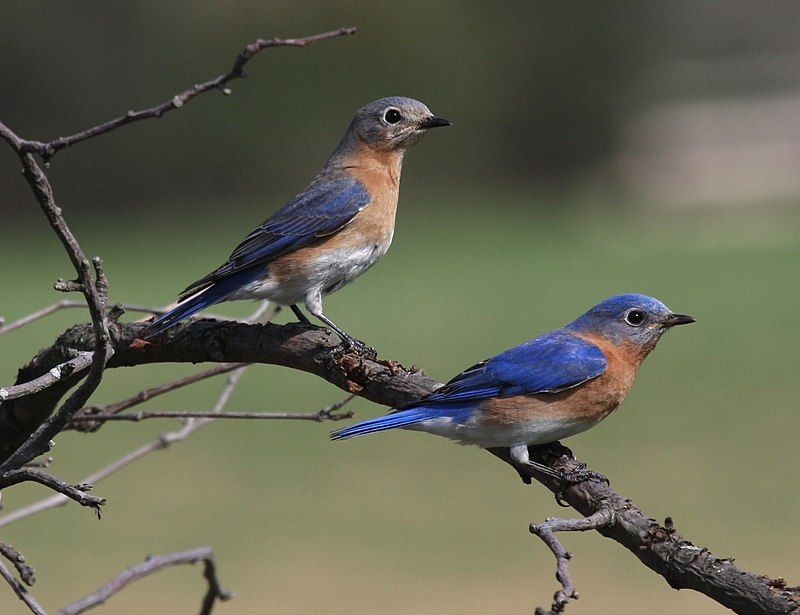
The Eastern Bluebird is a species of migratory bird found in North America. It is a small thrush, typically measuring between 6 and 7 inches in length. The male has striking blue plumage, which is the main reason why it is so popular with birders.
It can be seen perched on a wire or in open woodlands, farmlands, and orchards. This species has adapted to living in these open habitats, as they provide the bird with plenty of food and a safe place to rest.
The Eastern Bluebird has a wide range of food sources, including insects, worms, berries, and occasionally small mammals. During the breeding season, the male and female form a pair and nest in a hole in a tree or in a nest box.
The female then lays 4–5 eggs and both parents take turns incubating the eggs and feeding the young.
The Eastern Bluebird is fairly common in many parts of North America, although its population has been declining due to habitat destruction, pesticide use, and competition from other species.
The species is currently listed as being of least concern as it is still widely distributed and its population is considered stable. Conservation efforts are ongoing to protect this species and its habitat.
| Kingdom | Animalia |
| Phylum | Chordata |
| Class | Aves |
| Order | Passeriformes |
| Family | Turdidae |
| Genus | Sialia |
| Species | S. sialis |
3. Western Bluebird
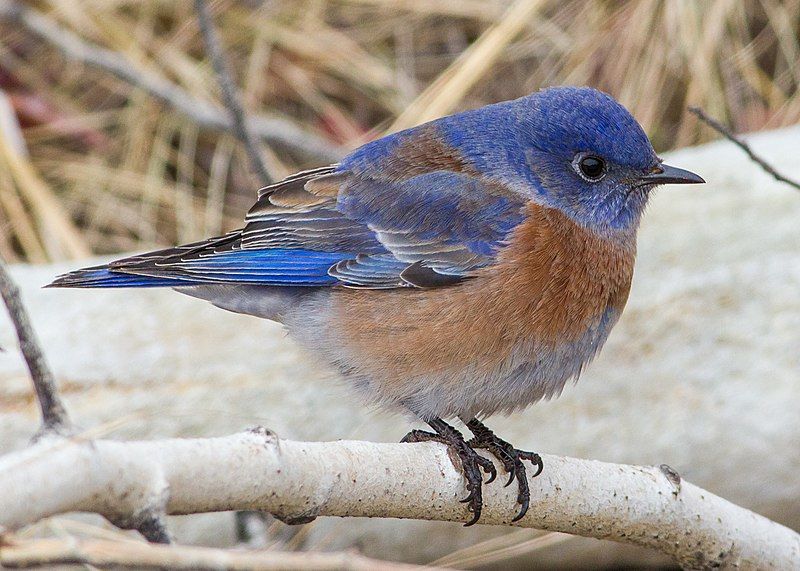
The western bluebird is a species of small thrush native to North America. It is a migratory bird, traveling from the northern parts of its range, such as Canada and Alaska, to the southern parts, like Mexico and California, during the winter months.
It is found in open woodlands, meadows, and fields. The western bluebird is a medium-sized bird, measuring about 7-8 inches in length and weighing around 1.3 ounces. Its plumage is generally a blue-gray color, with a bright orange-red breast.
It has a white throat and black chin, as well as a white patch on its wings. Its bill is black and its legs and feet are a light brownish color. The western bluebird is a mainly insectivorous species, eating mostly small insects and spiders.
It may also eat some berries or seeds. The western bluebird is an important species for the ecosystems it inhabits, as it helps to control insect populations. It is also an important species for people, providing a source of beauty and inspiration.
| Kingdom | Animalia |
| Phylum | Chordata |
| Class | Aves |
| Order | Passeriformes |
| Family | Turdidae |
| Genus | Sialia |
| Species | S. mexicana |
4. Mountain Bluebird
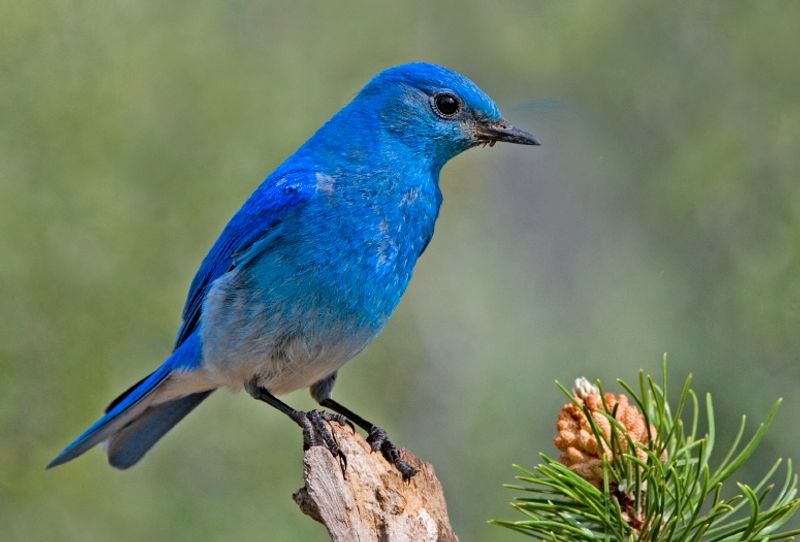
The mountain bluebird is a beautiful small bird native to western North America. It has a light blue or turquoise-blue color on its upper body and a lighter color underneath. Its eyes are black, and its bill is thinner than that of other thrush varieties.
During the summer, mountain bluebirds migrate to mountainous areas. They are common in the western United States and parts of Canada. Mountain bluebirds feed on insects and berries, and they often nest in cavities in trees or in the sides of cliffs.
They are social birds that flock together during migration and while they are breeding. Mountain bluebirds are an important species in their environment, as they help to control the insect population and disperse seeds from the berries they eat.
They are also a symbol of the beauty of North America’s mountain regions.
| Kingdom | Animalia |
| Phylum | Chordata |
| Class | Aves |
| Order | Passeriformes |
| Family | Turdidae |
| Genus | Sialia |
| Species | S. currucoides |
5. Painted Bunting
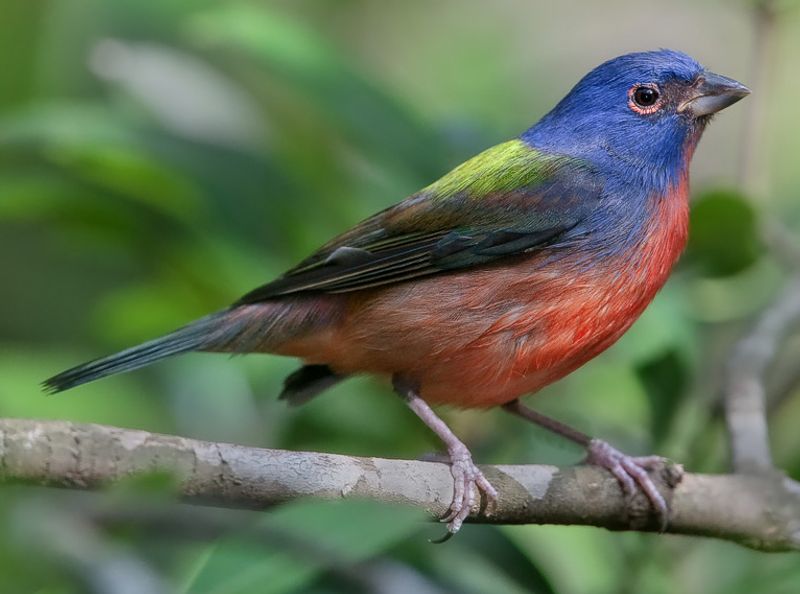
The painted bunting is a species of bird that belongs to the cardinal family, Cardinalidae. It is native to North America and has a very attractive plumage. The male-painted bunting has bright colors, which are not seen until the bird reaches its second year of life.
Before that, the only way to distinguish a male from a female is to take a close look at the bird. During the first year of a painted bunting’s life, its feathers are dull and lack the vibrant colors of adult birds.
After the second year of life, the male-painted bunting has a beautiful array of colors that includes blues, greens, reds, and yellows. The female-painted bunting is generally less colorful than the male but still has a vibrant mix of colors in its feathers.
The painted bunting is a unique species of bird that can be easily identified by its bright plumage.
| Kingdom | Animalia |
| Phylum | Chordata |
| Class | Aves |
| Order | Passeriformes |
| Family | Cardinalidae |
| Genus | Passerina |
| Species | P. ciris |
6. Barn Swallow
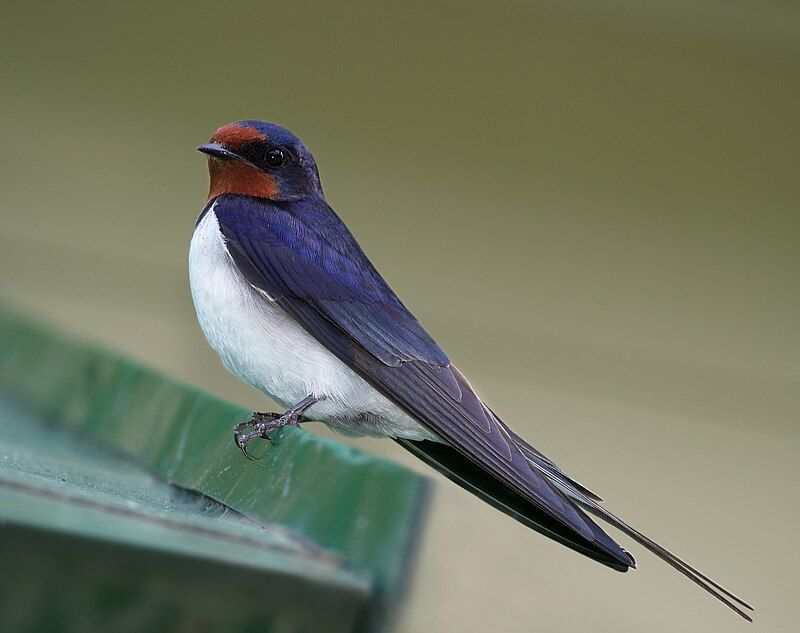
The barn swallow is an impressive bird species that can be found all around the world. It is a type of passerine or perching bird, and it is easily recognizable due to its blue upperparts and long, forked tail.
This species of swallow is especially widespread, with a range that extends over a staggering 251 million square kilometers. This range covers nearly every continent, making the barn swallow the most widespread species of swallow in the world.
The barn swallow is a medium-sized bird, with a wingspan of around 22 to 28 centimeters and a body length of around 16 centimeters. Its upper parts are a deep blue color, while the underparts are white and the tail is long and forked.
The male and female look very similar, although the male is slightly larger and darker in color. The barn swallow is an extremely agile bird, capable of flying and maneuvering at very high speeds. The barn swallow is a sociable bird, nesting and migrating in large flocks.
It is a migratory species, breeding in the northern hemisphere in the summer before traveling south for the winter. Its diet consists mainly of flying insects, which it hunts on the wing.
The barn swallow builds its nests under eaves or bridges or inside barns and other buildings. Overall, the barn swallow is an impressive and adaptable species, capable of thriving in a variety of habitats.
Its remarkable range and adaptability have enabled it to become the most widespread species of swallow in the world.
| Kingdom | Animalia |
| Phylum | Chordata |
| Class | Aves |
| Order | Passeriformes |
| Family | Hirundinidae |
| Genus | Hirundo |
| Species | H. rustica |
7. Steller’s Jay
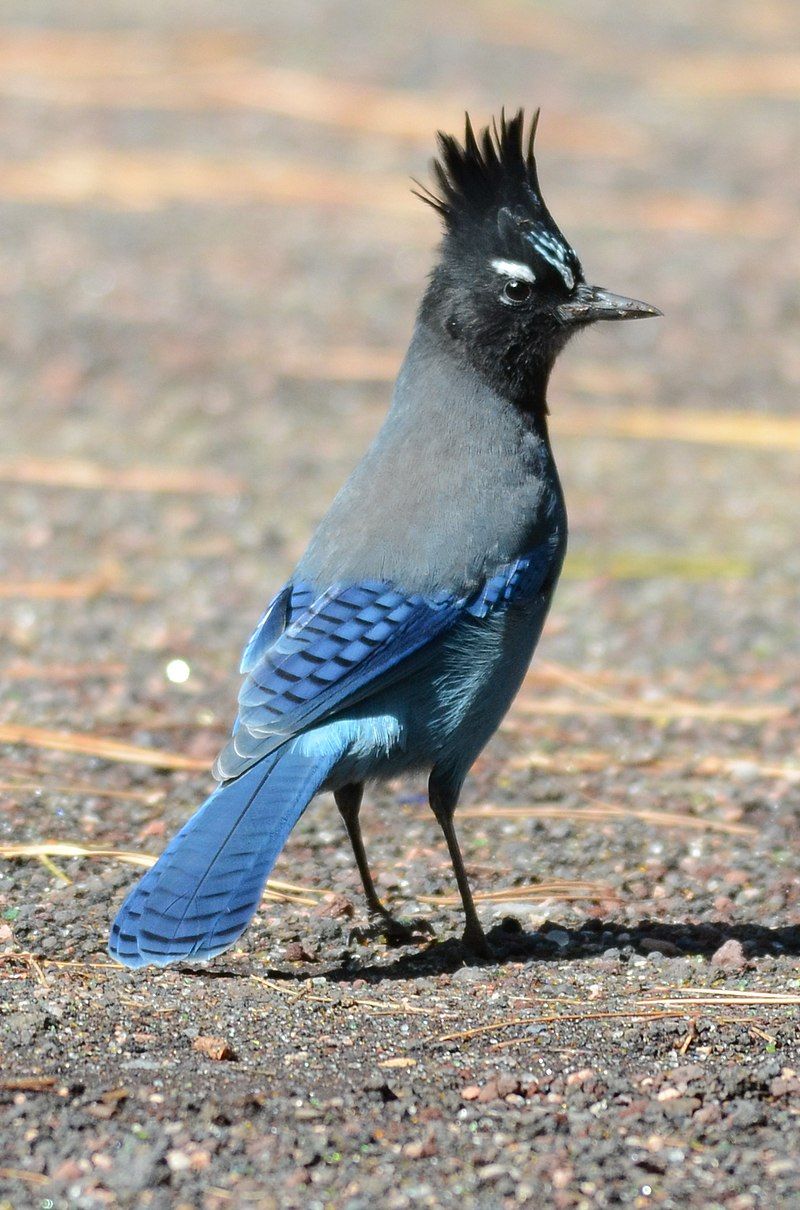
Steller’s jay is a vibrant and beautiful bird, native to western North America and the mountains of Central America.
It is closely related to the blue jay, which can be found in eastern North America, and is one of the few species of jays that is found on the other side of the Rocky Mountains. This makes Steller’s jay unique, as it is the only crested jay west of the Rocky Mountains.
It is easily identifiable due to its bright blue feathers, black head, white eye patch, and a crest of feathers on its head. Its diet consists of various fruits, nuts, insects, and small animals, and it can often be seen foraging in the forests.
Steller’s jay is also known for its intelligence and vocalizations, making it a popular species amongst bird watchers and animal lovers.
| Kingdom | Animalia |
| Phylum | Chordata |
| Class | Aves |
| Order | Passeriformes |
| Family | Corvidae |
| Genus | Cyanocitta |
| Species | C. stelleri |
8. Tree Swallow
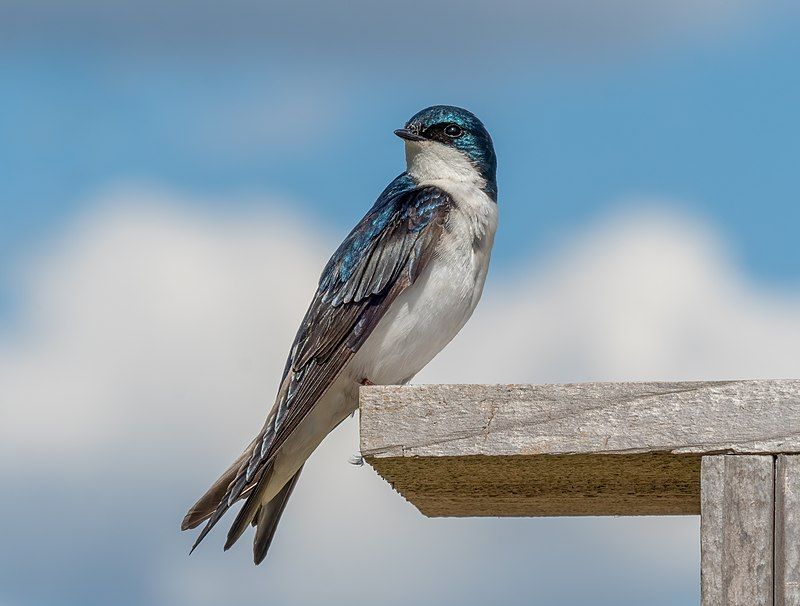
The tree swallow is a migratory bird that belongs to the family Hirundinidae. It inhabits the Americas and was first described by French ornithologist Louis Vieillot in 1807.
It was initially classified as Hirundo bicolor but has since been reclassified into the genus Tachycineta. Despite its current placement, there is still debate among scientists regarding the exact phylogenetic placement of the tree swallow within Tachycineta.
Tree swallows have an impressive migratory range – they can be found in North America, Central America, and the Caribbean. They nest in cavities in trees, fences, or buildings. Tree swallows feed mainly on insects, but they will also consume fruit and berries.
During winter, they can often be found near bodies of water, such as lakes, ponds, and rivers. Tree swallows are small birds, measuring about 15 cm in length. The males have a glossy blue-green back and head, with white underparts. The females are brownish-gray in color.
Both sexes have red throats, black bills, and forked tails. Tree swallows are a common sight in many parts of the Americas. They are usually seen in large flocks, often mixed with other species of swallows.
They are easily identified by their distinctive call, which is a short, high-pitched “tsip”. They are also known for their aerial acrobatics, which include swift and graceful dives and quick swoops.
| Kingdom | Animalia |
| Phylum | Chordata |
| Class | Aves |
| Order | Passeriformes |
| Family | Hirundinidae |
| Genus | Tachycineta |
| Species | T. bicolor |
9. Blue Grosbeak

The blue grosbeak is a species of passerine bird native to North America. It belongs to the family Cardinalidae, which is in the order Passeriformes. The male blue grosbeak is a striking bird, with its bright blue plumage and two brown wing bars.
The females are a duller blue-grey color with buffy-brown wings and a paler breast. The blue grosbeak is a migratory species, spending the winter in Central America and breeding in the southern United States and northern Mexico.
During the breeding season, the males are territorial and usually sing from an elevated perch. They feed on insects, seeds, and fruits, and often forage in flocks. The blue grosbeak is a fairly common bird, but its population is declining due to habitat loss and degradation.
Conservation efforts have been put in place to help protect their habitat, and it is classified as an endangered species in some areas.
| Kingdom | Animalia |
| Phylum | Chordata |
| Class | Aves |
| Order | Passeriformes |
| Family | Cardinalidae |
| Genus | Passerina |
| Species | P. caerulea |
10. Lazuli Bunting
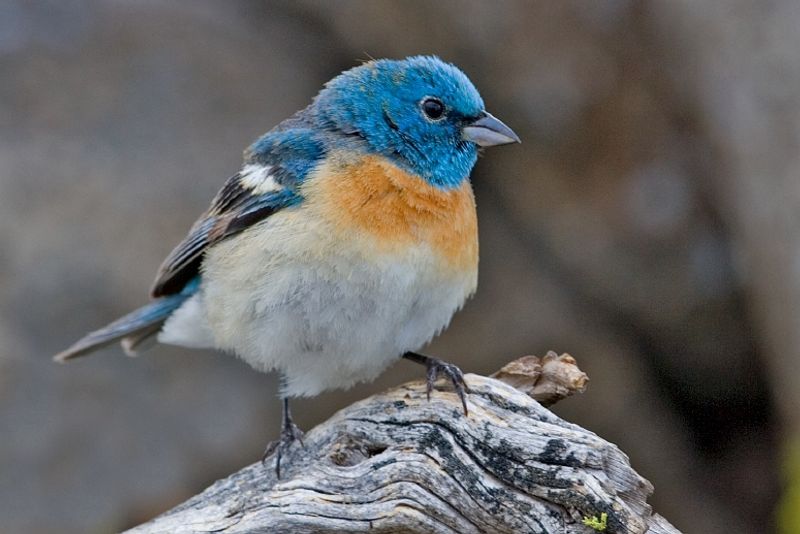
The lazuli bunting is a beautiful, small North American songbird. It is named after the precious gemstone lapis lazuli, which is a deep blue stone with golden flecks. This small bird is found in open grasslands, woodlands, and even in gardens and parks.
It has a bright blue head and chest, white streaks on its wings and back, and a white belly. The male is especially vibrant, with a deep blue head, a deep blue chest, and a bright white belly.
The female is a bit duller, with a grayish-brown head and chest, and white streaks on her wings and back. The lazuli bunting is a migratory species, meaning it leaves its breeding grounds in the summer and flies south for the winter.
During the summer months, it can be seen in the western United States and parts of Canada, while in the winter it can be found in Central America and parts of South America.
It feeds mainly on insects, as well as some seeds and berries. The lazuli bunting is a beloved backyard bird, often seen in bird feeders and nesting boxes. It is a popular bird to watch, especially during the spring and summer months when it is the most vibrant.
Its beautiful colors and cheerful song make it a welcome addition to any backyard.
| Kingdom | Animalia |
| Phylum | Chordata |
| Class | Aves |
| Order | Passeriformes |
| Family | Cardinalidae |
| Genus | Passerina |
| Species | P. amoena |
11. Blue Jay
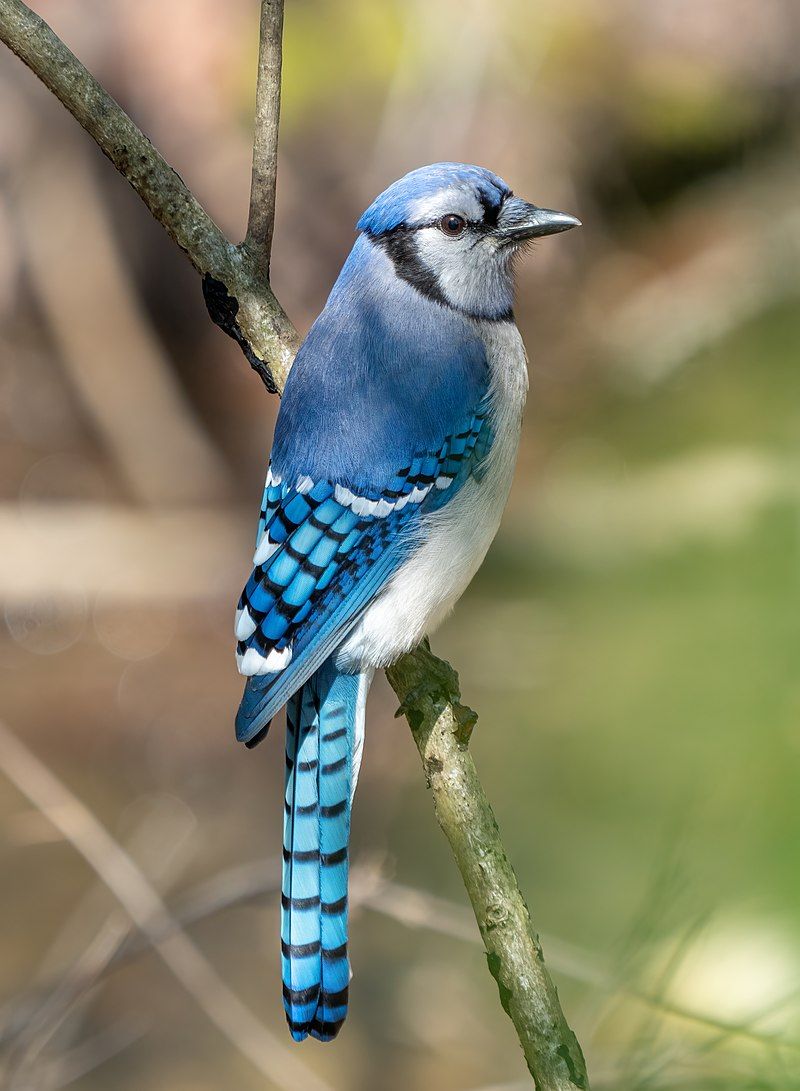
The blue jay is a type of member of the Corvidae family, which is a group of birds that includes crows, ravens, and jays. It is native to eastern North America and can be found across most of the eastern and central United States, including Newfoundland, and Canada.
In addition, there are breeding populations of blue jays found in southern Canada. This species of bird is usually resident in its chosen habitat, however, some eastern populations may migrate seasonally.
| Kingdom | Animalia |
| Phylum | Chordata |
| Class | Aves |
| Order | Passeriformes |
| Family | Corvidae |
| Genus | Cyanocitta |
| Species | C. cristata |
12. Belted Kingfisher
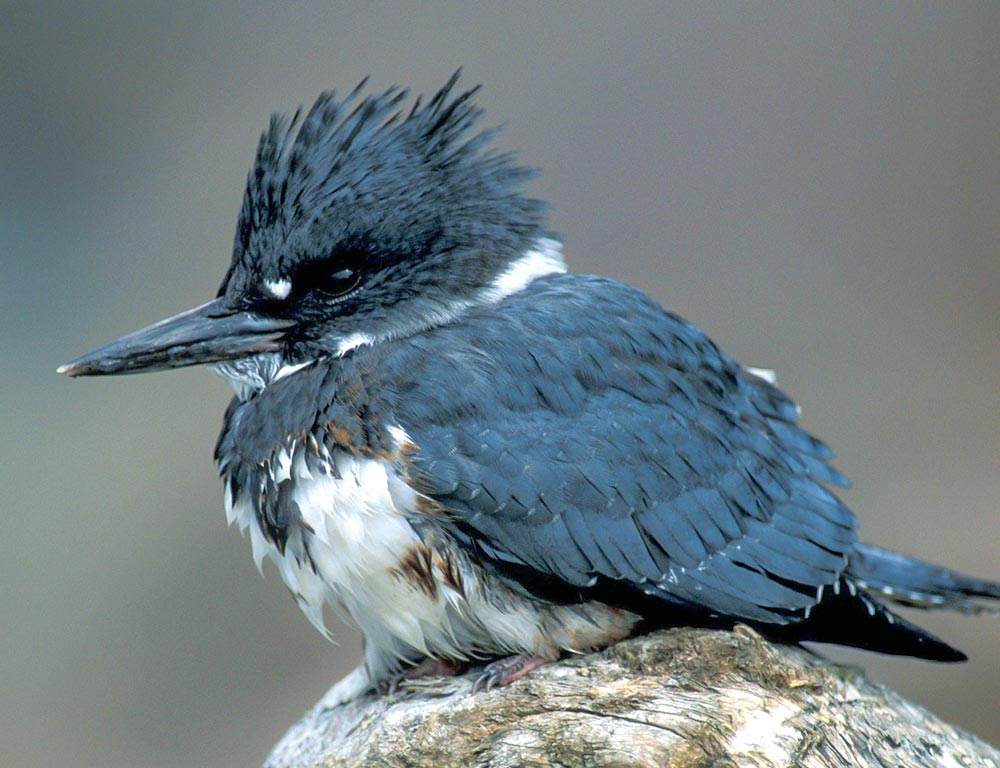
The belted kingfisher is a large, eye-catching bird that is native to North America. It is a member of the family Alcedinidae, which was formerly comprised of all kingfishers. However, recent research has suggested that this family should be subdivided into three subfamilies.
This research indicates that there is a need to further study the various species of kingfishers to determine their taxonomic relationships.
Kingfishers are a group of birds that inhabit wetlands and riverbanks, and they are known for their bright colors and distinct chirping calls. The belted kingfisher is easily recognizable by its large size and the light blue band that wraps around its chest.
It is a powerful flier, and it feeds mainly on fish, crayfish, and other aquatic creatures. This species is important to its local ecosystems as it helps to maintain the balance of the food chain by eating prey species.
Additionally, the belted kingfisher can help control insect populations, providing a valuable service to humans.
| Kingdom | Animalia |
| Phylum | Chordata |
| Class | Aves |
| Order | Coraciiformes |
| Family | Alcedinidae |
| Genus | Megaceryle |
| Species | M. alcyon |
13. Indigo Bunting
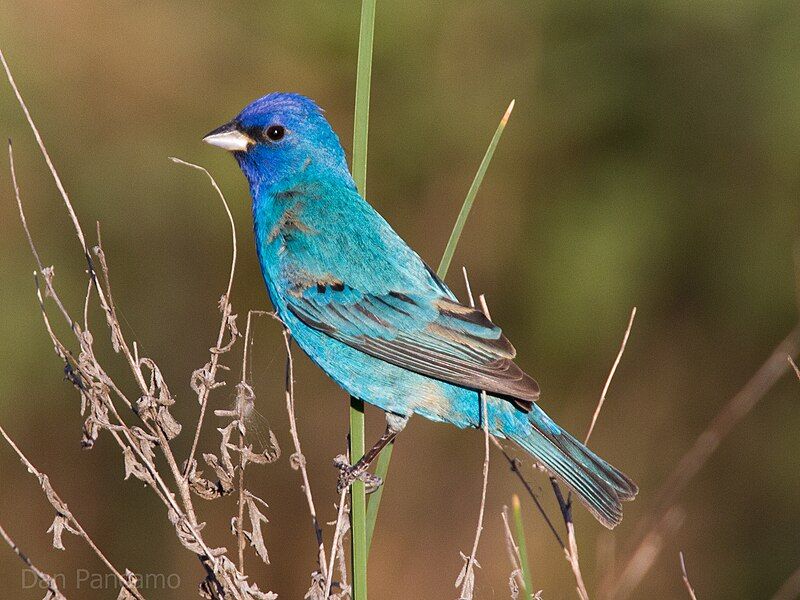
The indigo bunting is a small bird that belongs to the Cardinalidae family, which consists of seed-eating birds. It is migratory, which means it spends part of its life in one place and part in another.
During the breeding season, it ranges from southern Canada to northern Florida, and in the winter months, it travels south from Florida to northern South America. The indigo bunting migrates mainly at night, relying on the stars to guide it on its journey.
This type of navigation is known as celestial navigation and is used by birds and other animals to orient themselves in unfamiliar environments and to find their way back home.
By using the stars as a map, the indigo bunting can accurately and safely navigate its way to its destination.
| Kingdom | Animalia |
| Phylum | Chordata |
| Class | Aves |
| Order | Passeriformes |
| Family | Cardinalidae |
| Genus | Passerina |
| Species | P. cyanea |
14. Cerulean Warbler
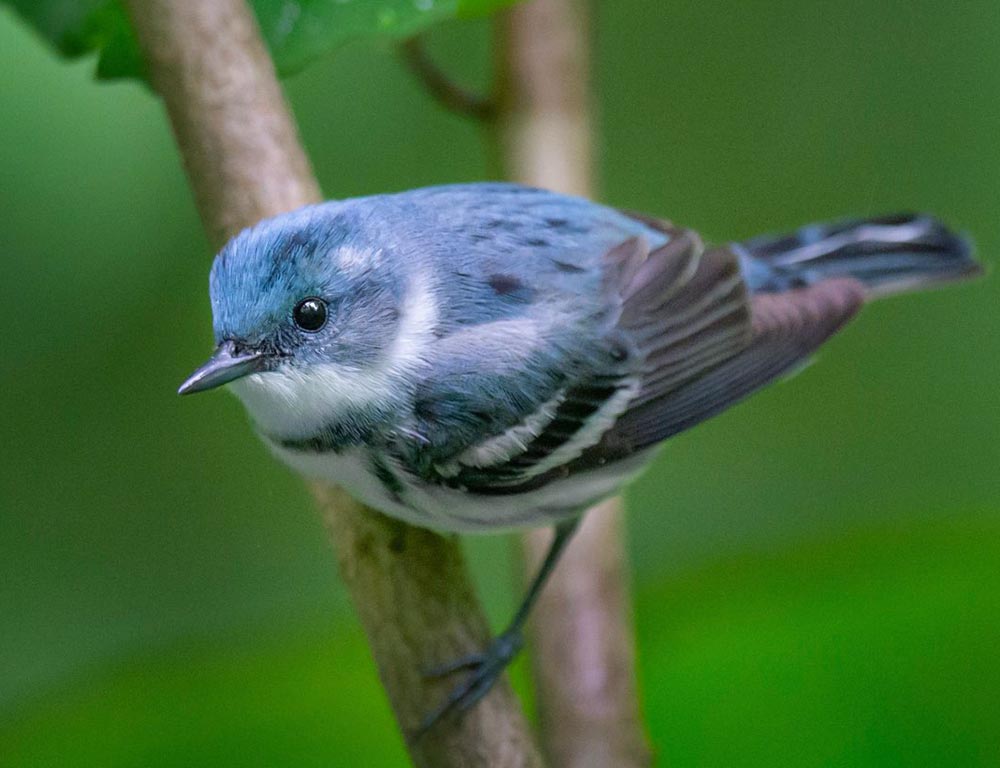
The cerulean warbler is a small, vibrant songbird belonging to the Parulidae family. It is a long-distance migrant, which means it travels a great distance each year to find suitable breeding grounds.
It breeds in the hardwood forests of eastern North America, and the wintertime, it migrates south to the eastern slopes of the Andes in South America. There, it prefers the subtropical forests for its winter home.
The cerulean warbler is an important species in the ecology of its range, as its presence helps to disperse seeds and maintain healthy habitats. Its long-distance migration also helps to spread genetic diversity across its range, allowing for genetic diversity among the species.
The cerulean warbler is a remarkable bird that is an important part of its ecosystem.
| Kingdom | Animalia |
| Phylum | Chordata |
| Class | Aves |
| Order | Passeriformes |
| Family | Parulidae |
| Genus | Setophaga |
| Species | S. cerulea |
15. American Purple Gallinule
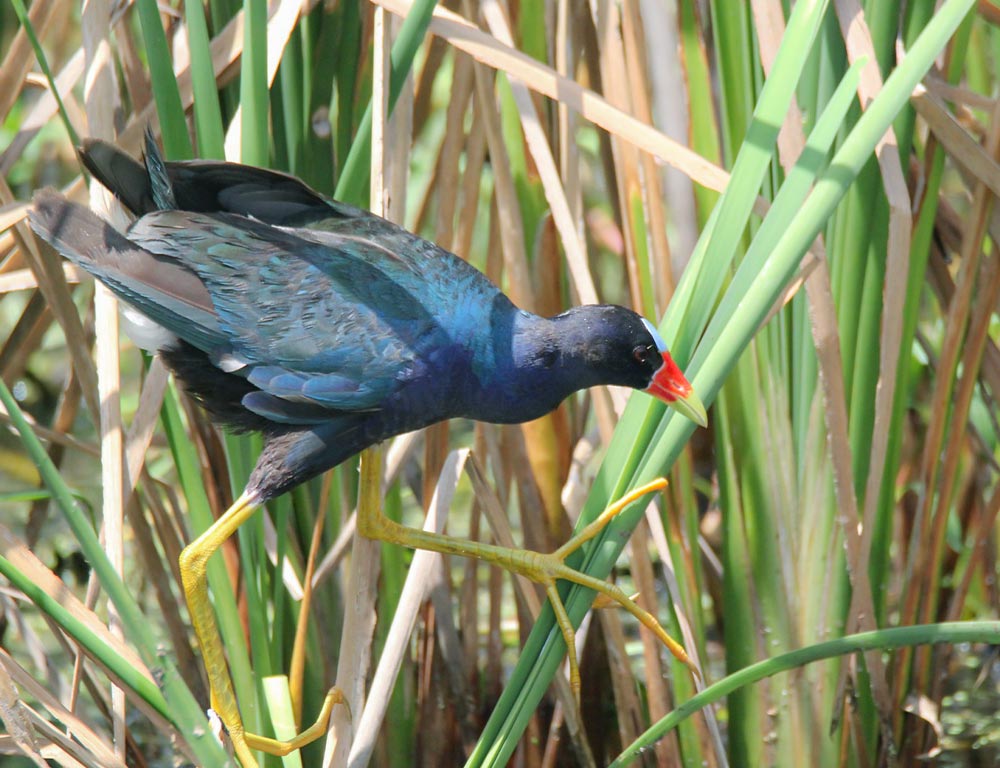
The purple gallinule is a species of swamphen found in the genus Porphyrio. This species, along with cranes, rails, and crakes, is part of the order Gruiformes, which is derived from the Latin word for “crane-like”.
Within the order, the purple gallinule is classified as a rail species, falling under the family Rallidae. It is also commonly referred to as the yellow-legged gallinule by local populations.
In terms of its physical appearance, the purple gallinule is a medium-sized bird with a black head, bluish-purple feathers, and bright yellow legs. It has an orange bill and a white stripe that extends from its forehead down to its nape.
The purple gallinule is a social species, commonly seen foraging in wetlands for food in large flocks. It primarily feeds on insects, but also consumes amphibians, fish, and aquatic vegetation.
| Kingdom | Animalia |
| Phylum | Chordata |
| Class | Aves |
| Order | Gruiformes |
| Family | Rallidae |
| Genus | Porphyrio |
| Species | P. martinicus |
16. California Scrub Jay
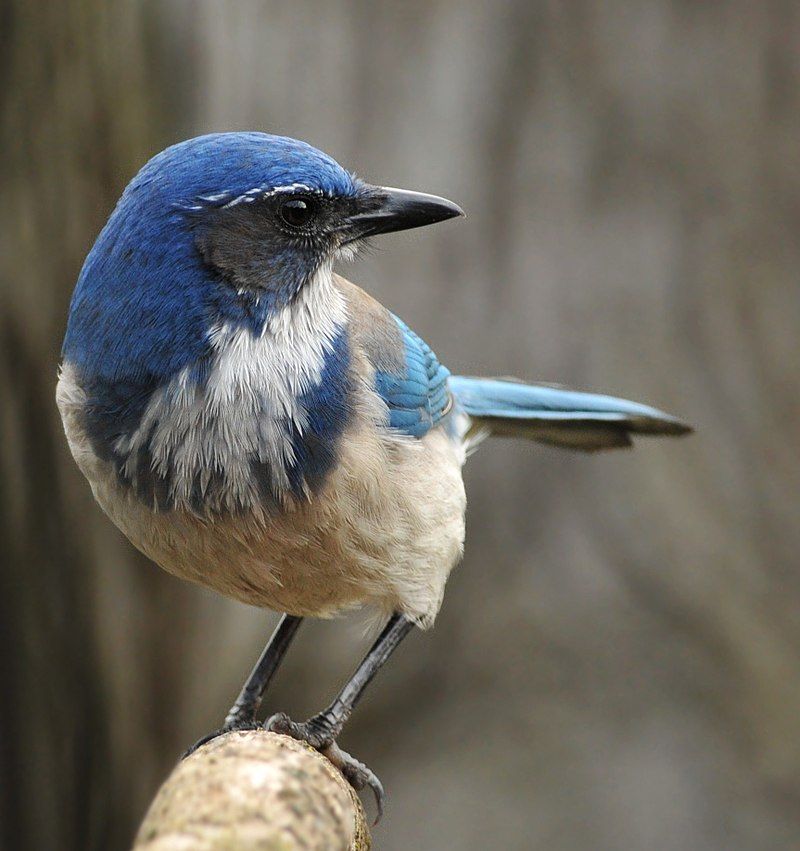
The California scrub jay is a species of bird that is native to the western parts of North America. Its range extends from South British Columbia down to California and western Nevada near Reno, and it extends even further to the west of the Sierra Nevada.
It is a medium-sized bird, with a wingspan of around 28-31 cm and a total length of around 20-22 cm. The California scrub jay is found in a variety of habitats, including oak-pine woodlands, chaparral, and riparian zones.
They have a highly varied diet, consisting of insects, acorns, fruits, berries, and eggs from other birds. The birds are also known to cache food, burying it for later consumption.
The California scrub jay is a highly social species, and they often live in groups of up to 15 individuals. They are also known to form long-term, monogamous pairs, with the male and female sharing the responsibility of caring for their young.
These birds are also known for their intelligence, and their problem-solving skills. Overall, the California scrub jay is a fascinating bird, and its presence is an important part of the biodiversity of western North America.
It is a species that is worth protecting and preserving and one that should be appreciated for its beauty and its intelligence.
| Kingdom | Animalia |
| Phylum | Chordata |
| Class | Aves |
| Order | Passeriformes |
| Family | Corvidae |
| Genus | Aphelocoma |
| Species | A. californica |
17. Cyanocitta
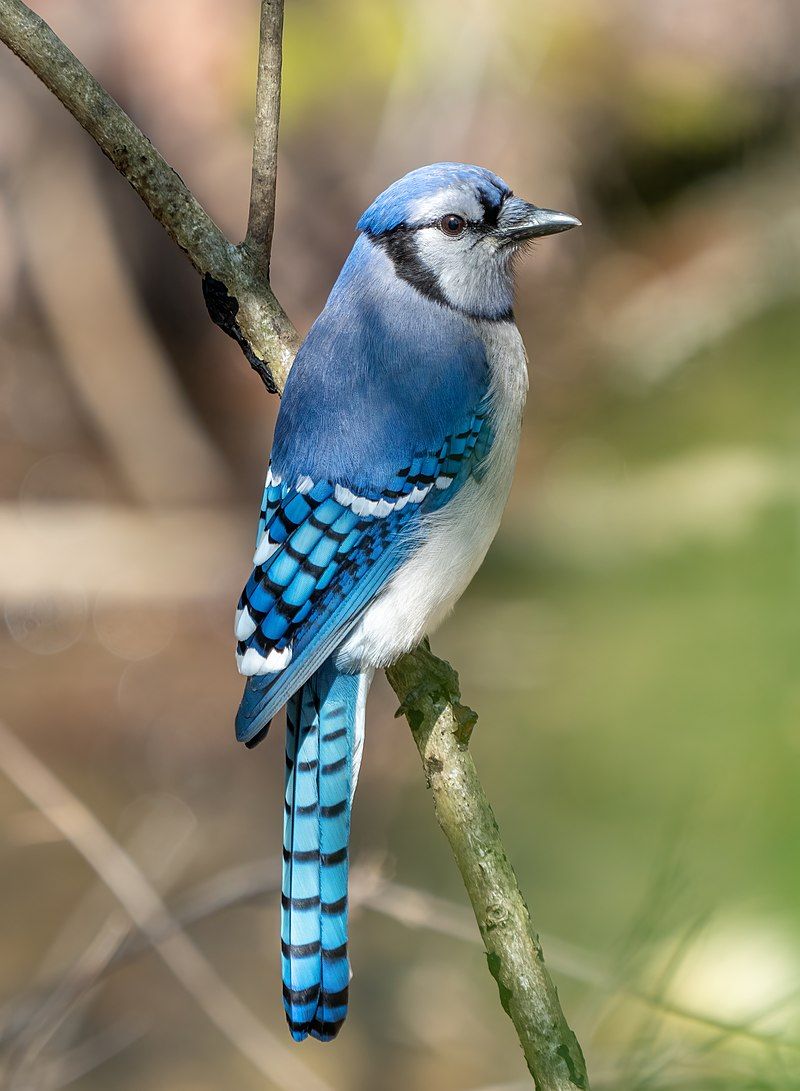
Cyanocitta is a genus of birds in the Corvidae family, which includes crows, jays, and magpies. This genus was first established by Hugh Edwin Strickland in 1845 and currently includes several species.
The name Cyanocitta is derived from two Greek words, kuanos, meaning “dark blue”, and kitta, meaning “jay”. This name was chosen to reflect the common colors of birds in this genus, which generally feature a combination of blue and gray tones.
The birds in this genus are found in a variety of habitats, from suburbs to forests to grasslands, and are often seen foraging for food on the ground or in trees. They are usually quite common and are often seen in small flocks.
| Kingdom | Animalia |
| Phylum | Chordata |
| Class | Aves |
| Order | Passeriformes |
| Family | Corvidae |
| Genus | Cyanocitta |
18. White-Breasted Nuthatch
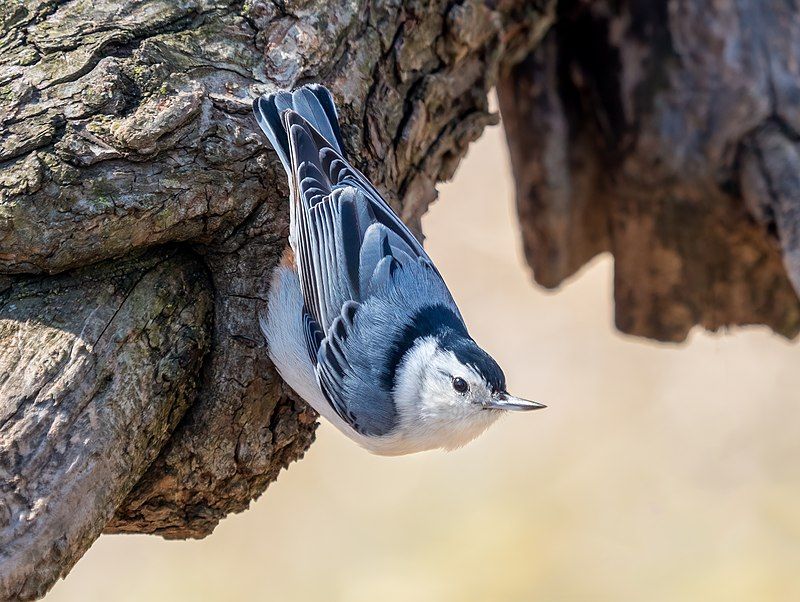
The white-breasted nuthatch is a small bird belonging to the Sittidae family. It is typically 15.5 centimeters in length, making it a medium-sized nuthatch. This species has a white breast and a black cap, which distinguishes it from other members of its family.
Its back is covered with gray-brown feathers, and its wings are brownish-black. It also has a short, strong bill which is black. The White-breasted Nuthatch is a very active bird, as it spends much of its time climbing up and down tree trunks and branches.
It uses its bill to dig into tree bark to find food, which mostly consists of insects and their larvae. It is a social species, often found living in small flocks, and is known to forage in mixed-species flocks.
This species is quite common in wooded areas throughout much of North America and is a common sight in many suburban backyards.
| Kingdom | Animalia |
| Phylum | Chordata |
| Class | Aves |
| Order | Passeriformes |
| Family | Sittidae |
| Genus | Sitta |
| Species | S. carolinensis |
19. Red-Breasted Nuthatch
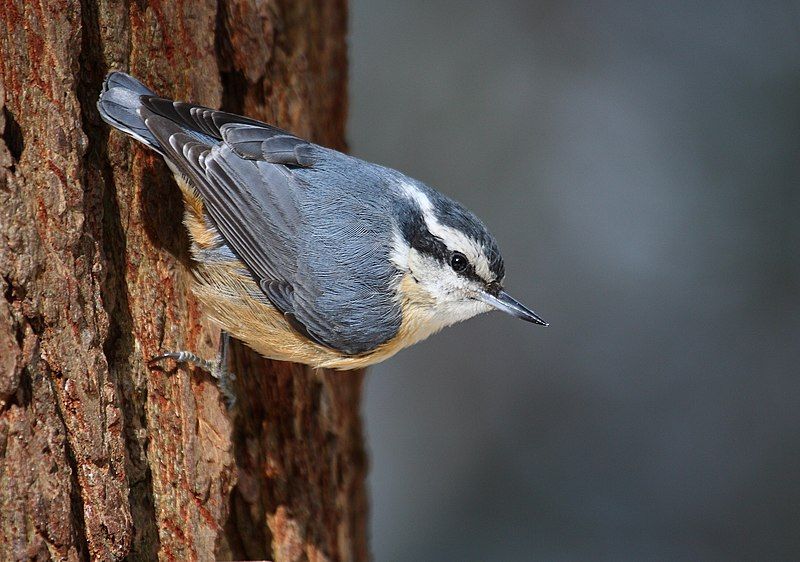
The red-breasted nuthatch is a small bird, easily identified by its distinctive plumage. Its upper body is mostly blue-grey, while its underparts are a light cinnamon color. It has a white throat, a face, and a black stripe running through the eyes.
The nuthatch’s bill is straight and grey, while its head is crowned with black feathers. Its song is high-pitched and nasal, having been compared to the sound of a tin trumpet.
This sound is often heard in wooded areas, where the nuthatch makes its home and can be seen searching for food. It often hangs upside down on tree trunks in order to reach food, and is also known to feed on the ground.
As well as its call, the nuthatch produces a variety of other vocalizations, including whistles, trills, and rattles.
| Kingdom | Animalia |
| Phylum | Chordata |
| Class | Aves |
| Order | Passeriformes |
| Family | Sittidae |
| Genus | Sitta |
| Species | S. canadensis |
20. Common Grackle
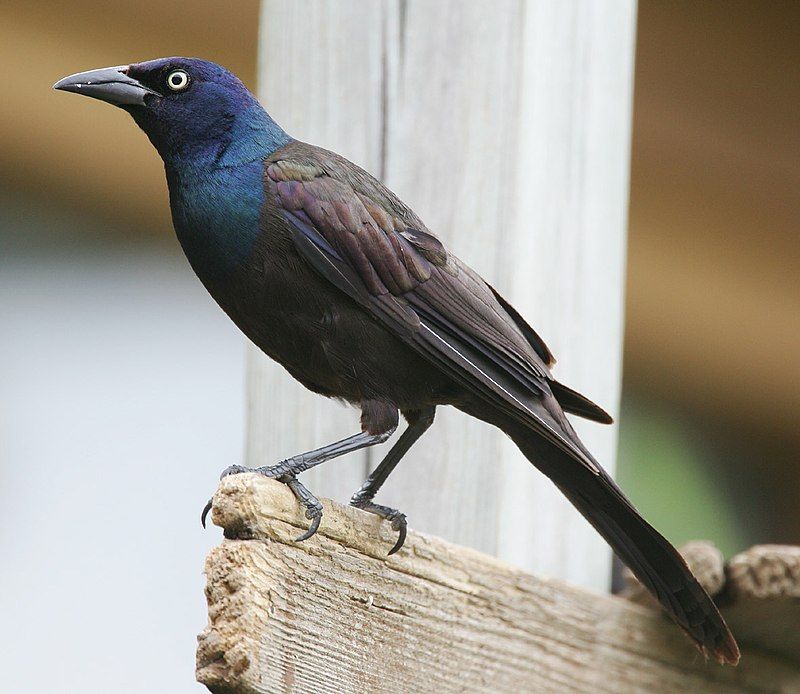
The common grackle is a species of icterid bird, which is also known as the “New World blackbird”. It is native to much of North America, and can typically be found in large flocks. The species was first described in 1758 by the famous Swedish naturalist Carl Linnaeus.
The common grackle has three distinct subspecies, each of which can be distinguished by certain physical characteristics. Adult common grackles are easily recognizable by their long and dark bills, pale yellow eyes, and long tails.
They have a glossy black plumage, with a green or purple iridescence. Grackles are also known for their loud and raucous calls, which they use to communicate with each other.
They are omnivorous and eat a wide variety of both plant and animal matter, including seeds, fruits, insects, and other small animals.
| Kingdom | Animalia |
| Phylum | Chordata |
| Class | Aves |
| Order | Passeriformes |
| Family | Icteridae |
| Genus | Quiscalus |
| Species | Q. quiscula |
21. Tit
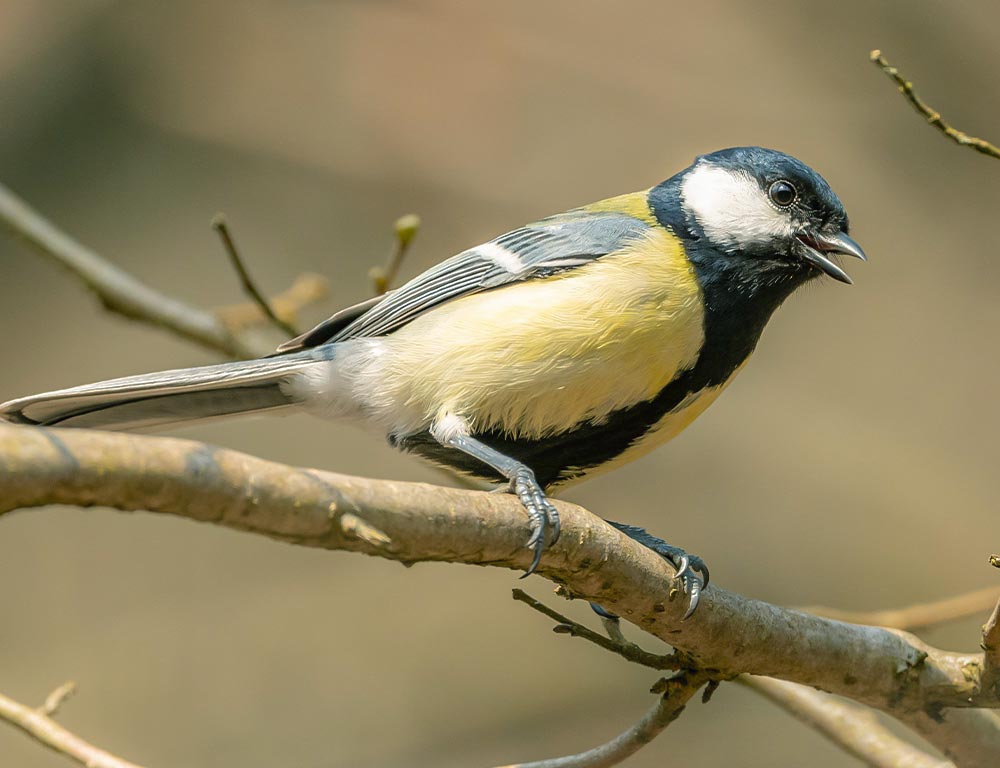
The Paridae is a large family of birds that are mainly found in the Northern Hemisphere and Africa. These birds are small passerines, often referred to as tits, chickadees, or titmice. They were all originally classified in the same genus, Parus.
The Paridae family is interesting because they can survive in a variety of climates and habitats. They are also able to adapt to different food sources, depending on the season.
They are considered to be a very versatile species and can be found in many different parts of the world. They are also known to form large flocks during the winter months, which can be seen flying in large groups.
In addition, they are known to be very vocal birds and can be heard making a variety of sounds. They are a very important part of the ecosystem, helping to keep the environment in balance.
| Kingdom | Animalia |
| Phylum | Chordata |
| Class | Aves |
| Order | Passeriformes |
| Family | Paridae |
22. American Robin
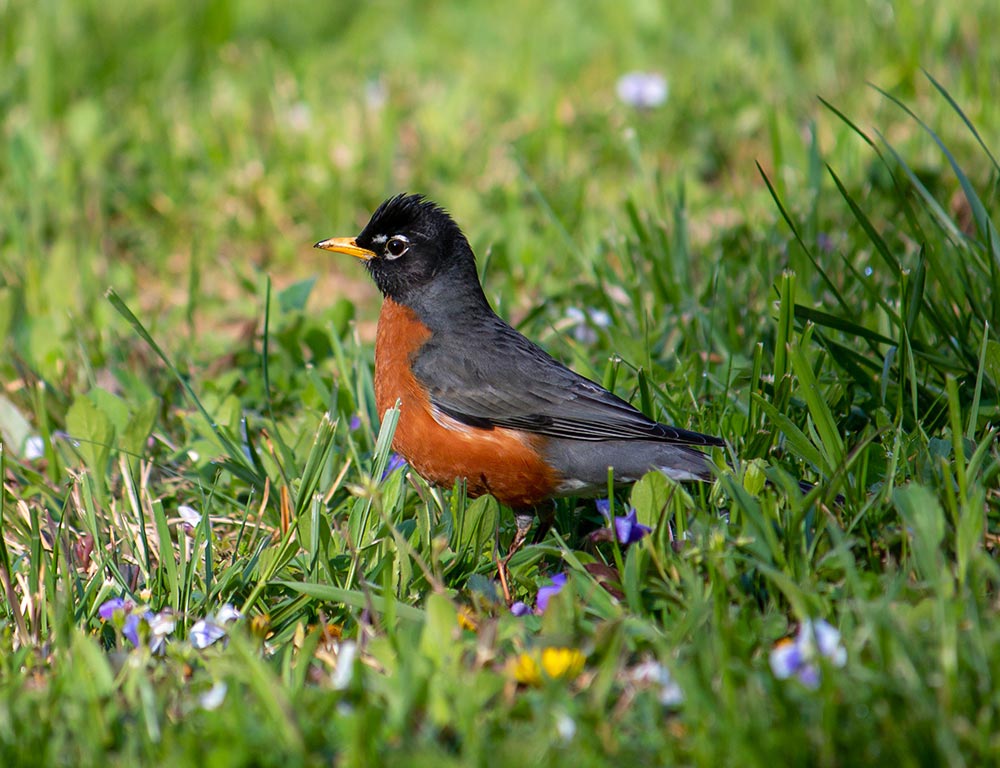
The American robin is a migratory bird that belongs to the true thrush genus and Turdidae family, which is part of the wider thrush family. It is called the American robin because its reddish-orange breast resembles that of the European robin.
However, despite their similar appearances, the two species are not closely related. The European robin is part of the Old World flycatcher family, while the American robin is in the true thrush genus and Turdidae family.
The American robin is a migratory bird, meaning it travels from one place to another in the same season. It has a reddish-orange breast and is found throughout North America. It primarily eats insects, fruits, and berries, and can be seen in both urban and rural areas.
The American robin is a common sight during the spring and summer months, as it migrates south for the winter. The American robin is an important part of the ecosystem, as it helps to control insect populations and disperse seeds.
Its unique appearance makes it a beloved bird, and its presence is often associated with springtime and rebirth.
| Kingdom | Animalia |
| Phylum | Chordata |
| Class | Aves |
| Order | Passeriformes |
| Family | Turdidae |
| Genus | Turdus |
| Species | T. migratorius |
23. Gray Catbird
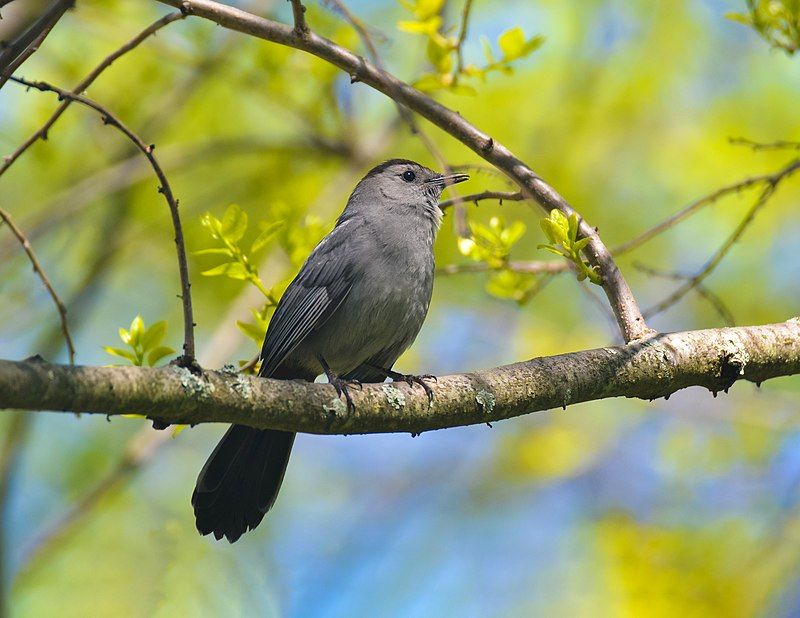
The gray catbird is a species of songbird native to North America and Central America. It belongs to the Mimidae family, which includes the mockingbirds and thrashers. The gray catbird is the only member of its genus, Dumetella.
It is a medium-sized bird, with a dark gray body and a black head and tail. The wings are black and white, and the eyes are yellow. The bill is black and thick. The gray catbird is most commonly found in wooded areas near water, such as marshes and swamps.
It feeds mainly on insects and fruits, and can often be seen hopping on the ground looking for food. It also has a distinctive call, which is a series of sharp, whistling notes. The gray catbird is a sociable bird and often forms large, noisy flocks.
During the breeding season, males will sing to attract a mate. They build a cup-shaped nest of twigs and grasses in trees or shrubs. The female will lay two to five eggs, which are white and marked with brown spots.
The young are born blind and helpless and are cared for by both parents. The gray catbird is not considered to be threatened or endangered, and its population is stable. It is a common sight in many parts of its range, and can often be seen in parks and gardens.
| Kingdom | Animalia |
| Phylum | Chordata |
| Class | Aves |
| Order | Passeriformes |
| Family | Mimidae |
| Genus | Dumetella |
| Species | D. carolinensis |
24. Boat-Tailed Grackle
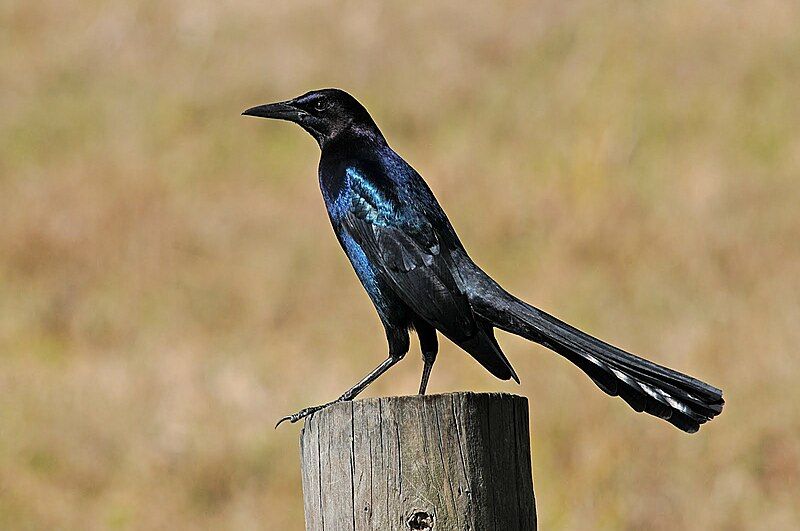
The boat-tailed grackle is a type of passerine bird, which is a member of the Icteridae family. This bird is found as a permanent resident on the coasts of the Southeastern United States. This bird can be identified by its long tail and glossy black feathers.
Its head and chest are deep blue-blacks in color, and its wings are black with a greenish-bronze sheen. The boat-tailed grackle has a wide range of vocalizations, including harsh rattles and buzzes, and melodious whistles.
It can be seen in small groups in marshes, parks, and beaches. In the wild, these birds tend to feed on insects, crustaceans, and other small animals, as well as scavenge for food.
The boat-tailed grackle is a unique and interesting bird and an interesting addition to the Southeastern United States.
| Kingdom | Animalia |
| Phylum | Chordata |
| Class | Aves |
| Order | Passeriformes |
| Family | Icteridae |
| Genus | Quiscalus |
| Species | Q. major |
25. Varied Bunting
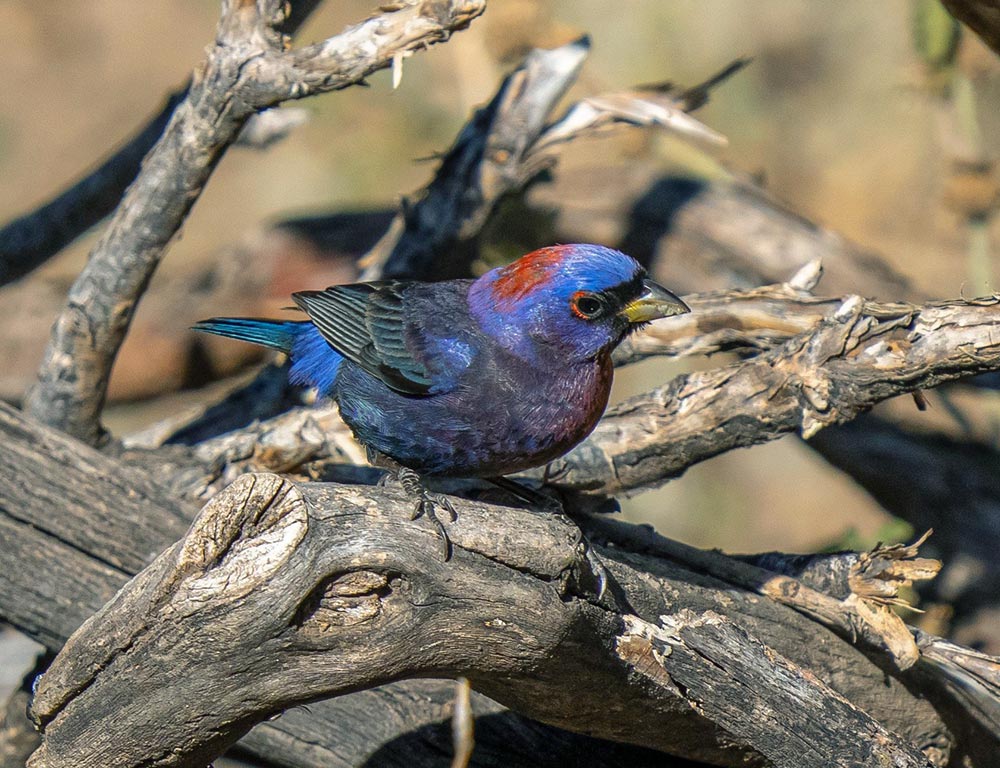
The varied bunting is a species of songbird found in the cardinal family, Cardinalidae. This species is native to North America and is found in the southern parts of Arizona, New Mexico, and Texas in the United States.
Additionally, the range of the varied bunting stretches south into Mexico as far as Oaxaca. The varied bunting is a small bird that is approximately 4 to 5 inches in length. It is brightly colored with a yellowish-green head and a grayish-blue back.
It has a black patch on its throat and chest, and its wings and tail are streaked with black. This species is most commonly found near open woodlands, grasslands, and semi-arid scrublands. The varied bunting is a seed-eating species that prefers to feed on the ground.
It has a variety of calls that include both a warble and a chatter. Its diet consists mainly of a mixture of grains, insects, and fruits. The varied bunting is an important species to North American ecosystems.
It plays a role in maintaining the health of the ecosystems by eating insects, which helps to control their population size. Additionally, the varied bunting helps to disperse the seeds of plants, which can help to promote the growth and spread of vegetation.
Overall, the varied bunting is an important species that plays an important role in North American ecosystems. Its range stretches from the southern parts of Arizona, New Mexico, and Texas in the United States south throughout Mexico as far as Oaxaca.
| Kingdom | Animalia |
| Phylum | Chordata |
| Class | Aves |
| Order | Passeriformes |
| Family | Cardinalidae |
| Genus | Passerina |
| Species | P. versicolor |
26. Blue Mockingbird
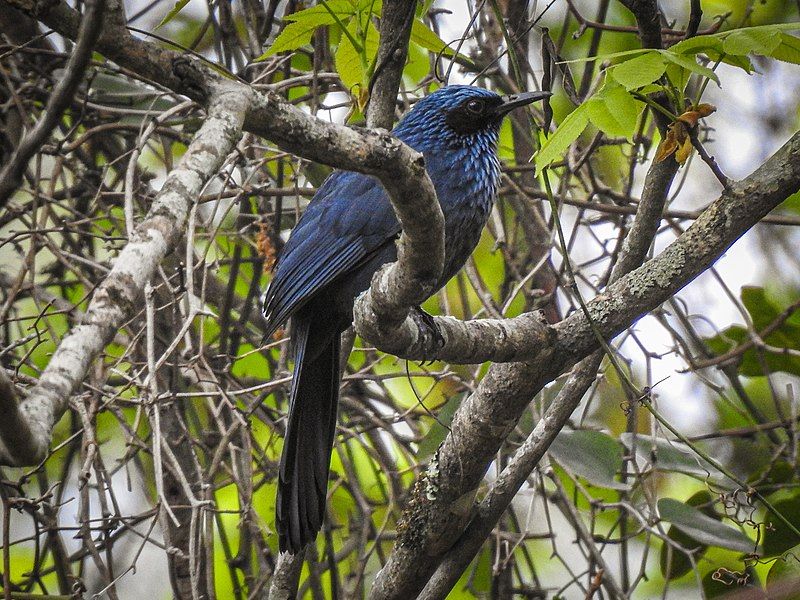
The blue mockingbird is a species of bird found in the family Mimidae. This species of bird is native to Mexico, though occasionally it has been spotted as a vagrant in the southern United States.
The blue mockingbird typically inhabits subtropical or tropical dry forests, subtropical or tropical moist montane forests, and heavily degraded former forests.
It is important to note that these birds prefer warmer climates, and thus they are most commonly found in Mexico, where the temperatures are milder.
The blue mockingbird is a species that is quite adaptable, as it can live in a variety of environments, from dry to moist and montane.
It is also able to live in heavily degraded former forests, which shows its resilience and ability to survive in a variety of conditions.
| Kingdom | Animalia |
| Phylum | Chordata |
| Class | Aves |
| Order | Passeriformes |
| Family | Mimidae |
| Genus | Melanotis |
| Species | M. caerulescens |
27. Black-Throated Blue Warbler
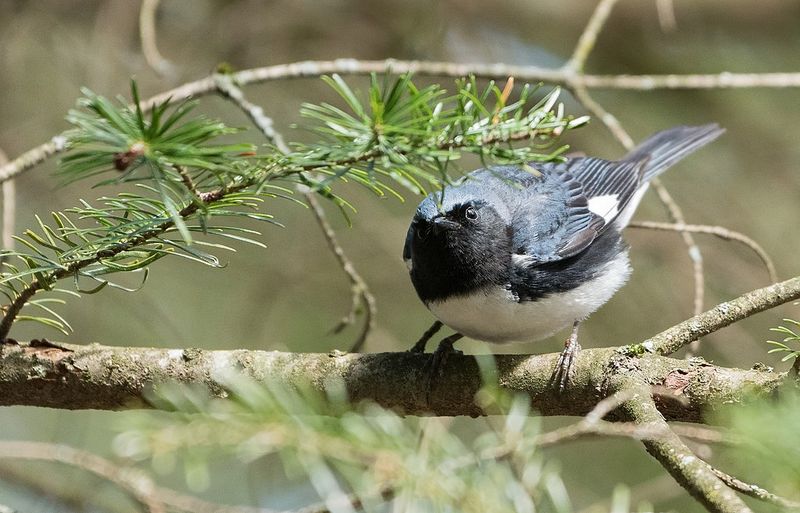
The black-throated blue warbler is a small passerine bird of the New World warbler family. It is found in the interior of deciduous and mixed coniferous forests in eastern North America. The warbler has a distinct black throat and a bright blue body.
During the cooler months, it migrates to warmer areas in the Caribbean and Central America. This migration helps the warbler to find more food, as well as provides a better climate for nesting and breeding.
The warbler’s habitat also provides it with the cover it needs to stay safe from predators. The warbler’s diet consists of insects, spiders, and other invertebrates, which it forages for in the canopy of trees.
It is important to protect the warbler’s breeding grounds and migration routes so that this species can continue to thrive.
| Kingdom | Animalia |
| Phylum | Chordata |
| Class | Aves |
| Order | Passeriformes |
| Family | Parulidae |
| Genus | Setophaga |
| Species | S. caerulescens |
28. Little Blue Heron
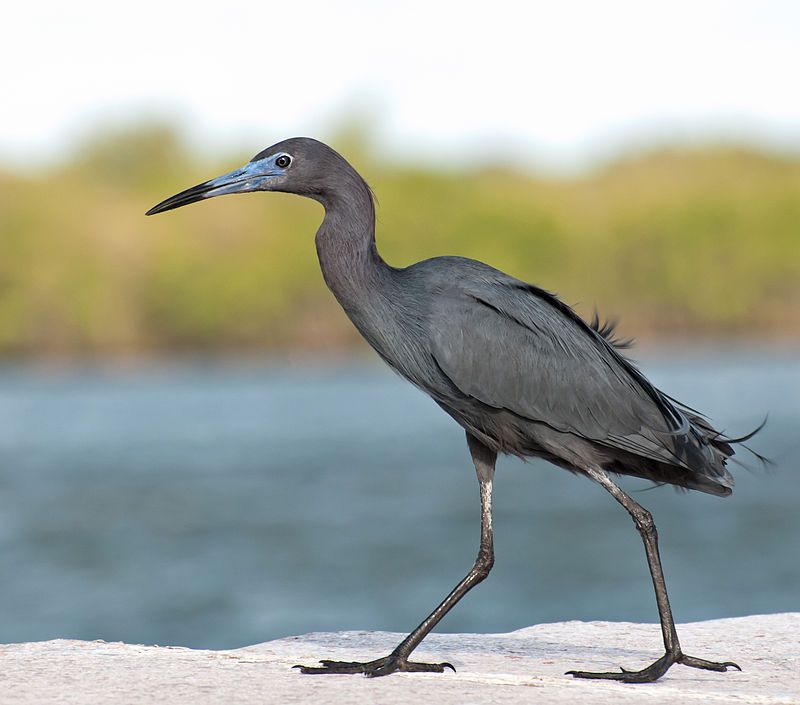
The Little Blue Heron (Egretta caerulea) is a small heron of the genus Egretta. It has a dark blue-gray body with a white belly and a two-toned bill. Juveniles are entirely white, with a similar appearance to the snowy egret.
During the breeding season, adults develop a distinctive coloration on their heads, legs, and feet. The head and neck of the adult bird are usually deep blue-gray, and the legs and feet become bright yellow.
The upper bill is black while the lower is yellow, giving it its two-tone appearance. The Little Blue Heron is a common sight in wetlands throughout the United States, Mexico, and parts of Central America.
It feeds on small fish, crustaceans, and insects that can be found along the shoreline. It is typically seen alone, but can occasionally be found in small groups.
The Little Blue Heron is an important species for conservation, as it is an indicator of healthy wetlands and shorelines.
| Kingdom | Animalia |
| Phylum | Chordata |
| Class | Aves |
| Order | Pelecaniformes |
| Family | Ardeidae |
| Genus | Egretta |
| Species | E. caerulea |
Conclusion
Bluebirds are a beautiful species of bird found in Texas. They bring a lot of beauty to the state of Texas, and they are a joy to watch and appreciate.
Bluebirds can be found in a variety of habitats, from open grasslands to woodlands, and they can also be seen at bird feeders and bird baths.
While their populations have been declining in recent years, conservation efforts have been put in place to help them survive and thrive in Texas.